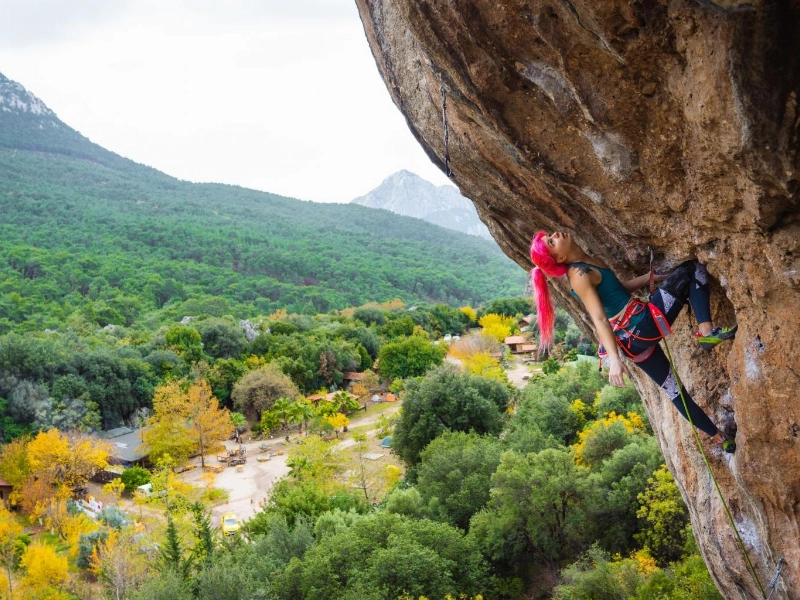Get in Shape by Climbing Rocks
A full-body exercise that increases strength and endurance is rock climbing. It's also a very efficient cardiovascular workout; studies have shown that it may burn calories at a pace that's similar to that of other cardio exercises like running.
Core muscles: As they move up the wall, climbers must maintain correct body alignment, which is dependent on their core muscles. Proper posture and the prevention of back discomfort are enhanced by strong core muscles.
Power

Almost every muscle in the body is worked when climbing, including the shoulders, back, and fingers and forearms. Moreover, maintaining the body parallel to the wall when climbing calls for strong core muscles. Additionally, the legs are employed as a source of force, particularly on more difficult courses that require a lot of positioning and reaching.
Additionally, you will need to raise yourself using your arms, which engages your rhomboids, trapezius, and latissimus dorsi (lats). Although this pulling motion is essential to the sport, seasoned climbers strive to avoid overusing their big back muscles.
Cross-train using other workouts that target the opposing "push" muscles to prevent this. Try jogging or performing some pistol squats, for instance. Incorporating this type of exercise into your climbing regimen will help shield you against burnout and injuries.
Adaptability

A rock climber uses most of the muscles in their body because they must push with their legs and pull with their arms. You also need balance to identify a good spot to move up the wall and the flexibility to adjust your centre of gravity to reach the next grip.
Climbing tones the upper body, which includes the shoulders, chest, and forearms. Along with strengthening the quadriceps (front thigh muscles) and glutes in the lower body, it also targets the back muscles and core.
It's a fantastic way to burn calories as well. Men should anticipate burning approximately 899 calories and women approximately 774 calories per hour of climbing. (That excludes the time needed for belaying, chalking up, and tying knots.)
Coordination

Climbing calls for both dexterity and strength in addition to control. The secret to success in this sport is to use the proper muscles at the right times. For example, you can use your forearms to gain the best grip on the tiny footholds that support you as you progress up a wall. It works your entire body since the constant pushing and pulling engages your antagonist muscles, which include your shoulders, biceps, back, and core, to produce balanced power.
Climbing instructors may teach novices how to begin with basic, manageable holds and work their way up to more challenging ones. Additionally, you can develop the muscle and coordination required for climbing by performing a few easy, focused workouts. These workouts consist of calf raises, pistol squats, and weighted squats.
Balance

Pushing and pulling using your legs, arms, shoulders, back, and core are all necessary for climbing. However, it also requires the engagement of isometric muscles, which stabilise you (like a plank). To travel up the wall, you have to coordinate all of this, which can be difficult if you don't have strong balance.
Additionally, rock climbing enhances your ability to solve problems. You learn which foot to plant when and how much weight to move up, utilising different areas of your body, as you repeatedly practice routes. It all comes together in the end, much like a choreographed dance.
Make sure to warm up with simple routes or difficulties and cool down with jumping jacks, jogging, and stretching to get the most out of your climbing session. Don't forget to stay hydrated!
Endurance

To keep your body parallel to the wall while climbing, you need core strength in addition to your arms and legs. Additionally, it requires a lot of breathing, which works your lungs. Additionally, defying gravity with all that effort can truly drain your energy!
More difficult routes require you to locate suitable handholds and footholds in risky locations and hang on for extended periods of time, frequently with no view of the ground below. This requires remarkable endurance, balance, and precise eye-hand-foot synchronisation. Additionally, the constant strain of climbing transforms your forearm muscles into powerful, vein-popping instruments of devastation. Climbing also aids in goal-setting, which boosts motivation levels. For instance, you push yourself beyond what you believe you are capable of once you learn a route that is above your present grade level.







